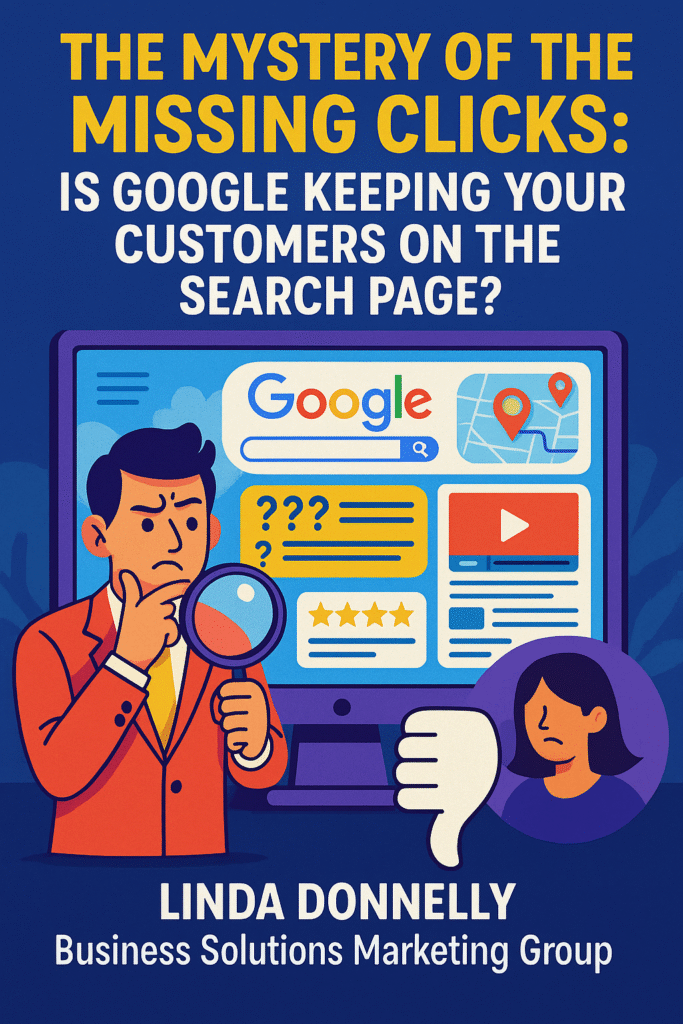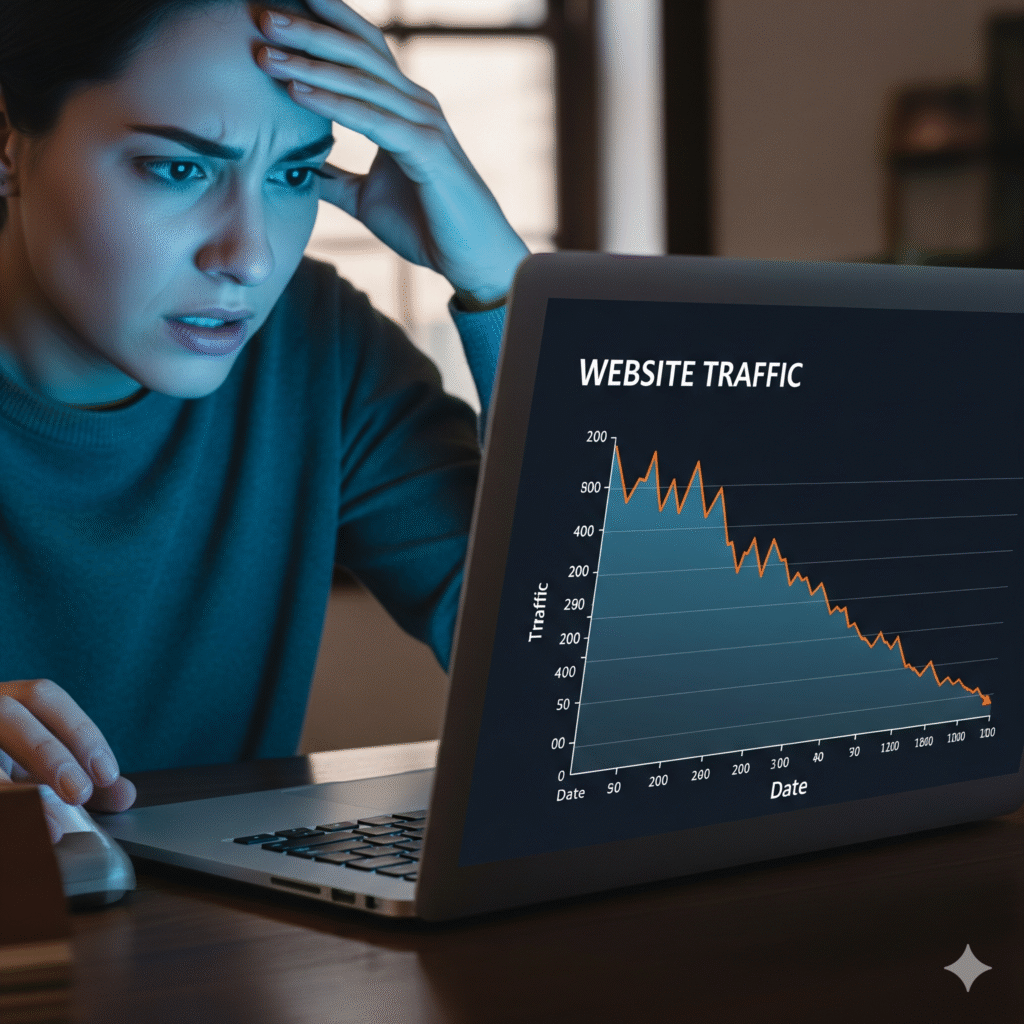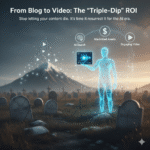Why Is My Website Traffic Declining, Even When My Rankings Are Good?
Hello, I’m Linda Donnelly from Business Solutions Marketing Group, and I’m here to talk to you about a problem that’s making a lot of business owners scratch their heads. You’ve put in the hard work. Your website is fast, your content is top-notch, and you’ve climbed the rankings for important keywords. But when you check your analytics, something just doesn’t make sense: your website traffic is down.
I’ve seen this happen time and time again over my decade in this business. Business owners come to me frustrated, wondering what they’re doing wrong. The truth is, it might not be you. It might be Google.
You see, Google has been changing. It’s no longer just a list of ten blue links. Today’s search results page, or SERP, is a lot more. It has maps, videos, shopping results, “People Also Ask” boxes, and, most importantly, instant answers in a little box right at the top of the page. These are called SERP Features, and they are Google’s way of giving a user an answer without them ever having to click on your website.
Think about it: when you search for “how to fix a leaky faucet,” Google might show you a list of steps or a short video right there on the search results page. The user gets their answer and never visits your site. This is what SEO experts call a “zero-click search.”
A study by SparkToro found that in the last year, over 58.5% of all Google searches result in no clicks at all. That’s a huge number! It means more than half the time, people find what they’re looking for right on the results page. For small businesses, this can be incredibly frustrating. It feels like Google is taking your hard-earned work and using it to keep people on their site, not send them to yours.

The Top SERP Features Stealing Your Clicks
So, which of these features are the biggest click-thieves? Understanding them is the first step to fighting back.
- Featured Snippets: This is the most famous one. It’s that little box at the top of the page that gives a direct answer to a question. Ahrefs reports that even with a featured snippet, there’s a serious drop in clicks for the organic search result. For example, the organic search result in the number one spot usually enjoys a 26% click-through rate, but when a featured snippet is present, that drops to just 8.6%. That’s a huge difference!
- People Also Ask (PAA) Boxes: You’ve seen these. They are a list of related questions that a user can click on to get more answers without leaving the search results page. This keeps users in Google’s ecosystem and away from your website.
- Knowledge Panels and Knowledge Graphs: These are those big boxes on the side of the search results page that have tons of information about a person, place, or thing. If your business is well-known, Google might create a knowledge panel for it, but if you’re not careful, it can pull information from other sources, keeping users from your website.
So, while these features can be frustrating, you can’t ignore them. Your strategy has to change from “ranking number one” to “being the best answer, no matter where it shows up.”
How to Adapt and Win in a “Zero-Click” World
This isn’t a fight you can win by just doing the same old things. You have to be smart and change your approach.
- Don’t Fight the Snippet, Be the Snippet: If Google is going to show an instant answer, you want that answer to be yours. To do this, you need to structure your content perfectly. For a question like “what is a marketing funnel?”, start your article with a clear, concise, two-sentence answer. Use headings like “What is a [Your Topic Here]?” and “How to [Do Something]?” This makes it easy for Google to find your content and use it as the instant answer.
- Focus on Content with Commercial Intent: Not all keywords are the same. A search for “what is a marketing funnel” is informational, and Google wants to answer it quickly. But a search for “best marketing funnel tools” has what we call commercial intent. The user is ready to buy something. You want to create content that targets these ready-to-buy users. Pages that compare products, list pros and cons, or offer “best of” guides are excellent for this.
- Use Schema Markup: This is a big one. It’s a type of code you put on your website that helps Google understand your content better. You can use it to tell Google that a page is a recipe, a how-to guide, or an FAQ section. This helps your content show up with those cool extra features in the search results, like star ratings or step-by-step instructions. We can help you with this! Check out our Google Business Listing Optimization service to learn more.
- Diversify Your Traffic Sources: Don’t put all your eggs in Google’s basket. A smart marketer knows that if you rely on just one source for traffic, you’re in trouble if that source changes. Use social media, email marketing, and video marketing to build a relationship with your audience and bring them back to your site directly. This is a big part of what we do. Learn more about it on our Video Marketing page.
Key Takeaways
- Traffic decline doesn’t always mean poor rankings. It can be a result of Google’s SERP features giving users answers without them needing to click on your site.
- Zero-click searches are a real thing. In the last year, over half of all Google searches ended without a click to a website.
- Your new goal is to be the best answer. This means optimizing your content not just for search, but for instant answers like Featured Snippets and People Also Ask boxes.
- Focus on high-value content. Create content that satisfies commercial intent and answers questions that Google can’t easily summarize.
- Diversify! Don’t rely solely on Google. Use other marketing channels like social media and email to build a loyal audience.
Five Most Asked Questions About Declining Website Traffic
- How can I tell if SERP features are affecting my traffic? The best way is to use Google Search Console. Look at your click-through rate (CTR). If you have a high ranking but a very low CTR, it’s a strong signal that a SERP feature is taking the clicks.
- Does ranking for a featured snippet help or hurt my traffic? It can do both! For some queries, it might get you a lot of clicks. For others, it might give the user the answer they need, so they don’t click. The benefit is you still get brand visibility and authority.
- How often should I check my website traffic? You should look at your traffic trends at least once a month, but a weekly check can help you spot issues early.
- Are there any tools that can help me track this? Yes. Tools like Semrush and Ahrefs have special features that show you which keywords have SERP features and if you are ranking in them.
- Should I stop writing blog posts about basic questions? No, you shouldn’t. Those basic questions are your chance to be the authority. Just make sure your blog posts are structured to become Featured Snippets, and then link to more detailed, high-value pages on your site.
External Resources to Help You Out:
- HubSpot’s Guide to Zero-Click Searches – This is a great resource for understanding the different types of zero-click searches.
- SparkToro’s Zero-Click Study – Check out the raw data from the study I mentioned. It’s eye-opening.
- Moz’s Whiteboard Friday on SERP Features – This video gives a great visual explanation of all the different SERP features and how they impact your SEO.
I hope this helps you understand the puzzle of declining traffic. The solution isn’t to work harder at the same things but to work smarter by adapting to Google’s new rules. If you need a partner to help you navigate this changing landscape, we’re here for you.
GBP LInk – https://g.co/kgs/GR8yH4a
LinkedIn – https://www.linkedin.com/company/business-solutions-marketing-group-llc/?viewAsMember=true
Instagram – https://www.instagram.com/business_solutions_mg/
Twitter – https://x.com/BSMGLLC
Facebook – https://www.facebook.com/BusinessSolutionsMarketingGroup
BlueSky: https://bsky.app/profile/bussolutions.bsky.social
TikTok – https://www.tiktok.com/@linda_donnelly
YouTube – https://www.youtube.com/channel/UC4w357-txvxOaHff2hTfSSg







